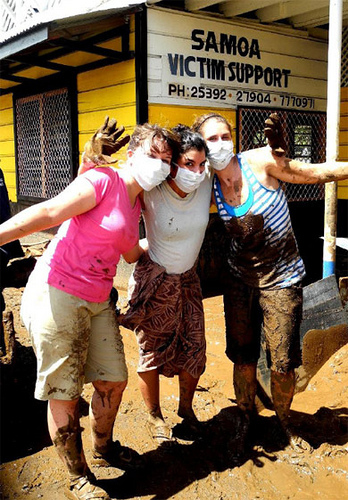Thirteen new United States Peace Corps Volunteers were sworn in last week and have taken up residence in various villages across Upolu and Savaii where they will live and work for the next two years. I could not fly up to greet them because of Cyclone Evan, but my Chargé Chad Berbert tells me that the group is enthusiastic, excited to be in Samoa, happy to be finished with their intensive 10-week Pre-Service Training, and ready for the field.

Our new arrivals (from left): Lou Chen, Teuila Pati, Mildred Andrews, Bradley Boelman, Angelina Velarde, Allyson Miller, my Chargé Chad Berbert, Michelle Paul, PC director Dale Withington, Rebecca Haas, Kate Brolley, Allyson Fraser, Kiri Center, Madisen Rhodes, Joshua Fraser, Zach Wegner, and Karen Acree.
During their extended time in Samoa the volunteers will work on a variety of projects, with a strong focus on improving primary school students’ English literacy. Several of the volunteers are going to villages that were severely affected by the cyclone, and they will help repair and rebuild schools as well as teach students and assist their adopted communities in additional ways.
Because of recent events we did not have a public arrival ceremony. Instead, the volunteers were sworn on my behalf by Chad at our offices in Matafele and then immediately deployed. The new arrivals spent their first day with Chad and our Embassy colleagues helping the Samoa Victim Support Group (SVSG) clean out its facility at the old police building, which had been badly battered by the storm.
The work was quite a challenge because the mud which innundated SVSG was more than a foot high in some places. Getting SVSG’s facility back into shape was a priority because in addition to everything else it does, SVSG had tacked immediately into assisting Samoans impacted by the cyclone. We were happy to pitch in. You can learn more about SVSG in the profile I posted earlier this year.
Our new volunteers are part of an extraordinary progression. Since President John F. Kennedy founded the Peace Corps on March 1, 1961, more than 200,000 Americans have served in 139 countries, spending two years or more of their lives working on health, education, water, food security, and development projects that have opened new horizons for children, extended and improved people’s lives, and uplifted entire communities.

In the Oval Office in March 1961, President John F. Kennedy hands to Sargent Shriver the pen used to sign the act creating the Peace Corps.
For more than 45 years of its history the Peace Corps has been present in Samoa. During that time more than 2,000 Americans have served here, living and working in villages and making a strong postive difference.
Neither the Peace Corps nor the volunteers always get the recognition and support that they deserve, but President Kennedy’s goal wasn’t to attract attention, generate indebtedness, or win thanks. It was simply to help people.
For that reason I’m a vigorous partisan of the program. I think that more folks back in the United States and abroad should learn about its history and current work.
So, when you have a moment, please check out my pertinent prior posts, including a warm remembrance of founding Peace Corps director Sargent Shriver and notes about my visits with volunteers when I’ve been in Samoa.
I’ll end today with one of my favorite quotes from Sargent Shriver, spoken at the University of Notre Dame in that turbulent year 1968. The words could be the Peace Corps’ — and indeed America’s — motto:
“We need to make a national examination of conscience. Why do we need a national examination of conscience? Because suddenly we Americans seem to be panicking. It’s time to stop moaning and wringing our hands. It’s true, the country is in a crisis. But we have always been in a crisis. We ought to thank God we are. Because then we always have something to test us — like a piece of steel that stays strong precisely because it is enduring great pressure.”
![]()
 RSS
RSS




































 View my Profile
View my Profile Connect with Wellington
Connect with Wellington Watch our Videos & Subscribe
Watch our Videos & Subscribe Watch our Videos on Vimeo
Watch our Videos on Vimeo Connect on GPlus
Connect on GPlus US Embassy NZ
US Embassy NZ


 Post Entries (RSS)
Post Entries (RSS)

